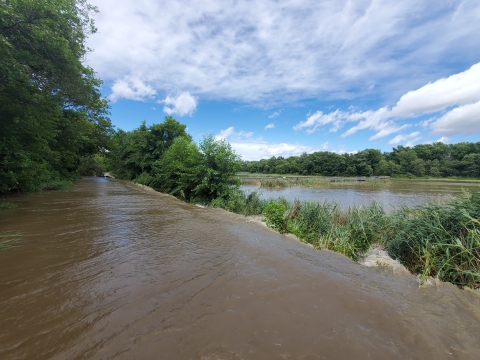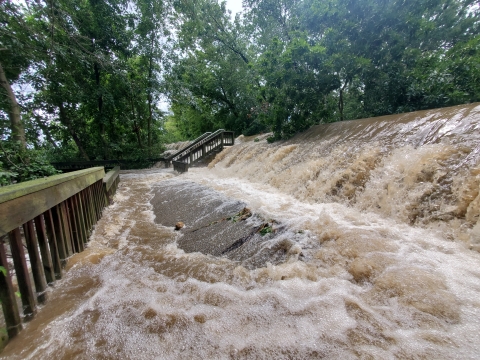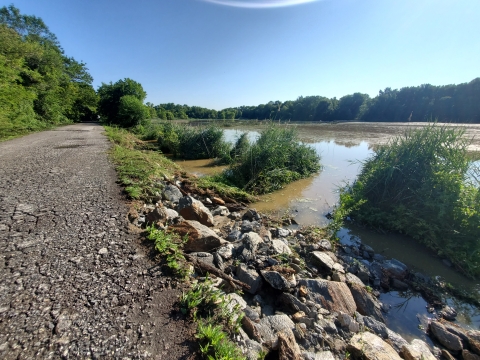Management and Conservation
Emergent Wetland Management
The Refuge is home to a roughly 145-acre emergent wetland where the Service manages water levels. Adjusting the water levels throughout the seasons maximizes the benefits for migrating birds, invertebrates, and plant communities. The water level can be lowered to expose mud flats that provide for feeding and resting areas during shorebird migration or raised during waterfowl migration for dabbling and diving ducks.
Invasive Species Management
Invasive plants on the Refuge, including Phragmites, Purple loosestrife, Bush honeysuckle, and Oriental bittersweet, out-compete native plants and, in turn, hurt the animals that rely on native plants for food and shelter. The Refuge’s goal is to remove the non-native plants and protect the biodiversity of our habitats.
The Refuge employs several techniques to control invasive plants including hand pulling and cutting, mowing, herbicides, and biological control. The Refuge relies heavily on volunteers to control invasive plants, through a volunteer group called the Weed Warriors. Weed Warriors meet on the second Saturday of every month from 9 am to 12 pm for Stewardship Saturdays. This is an open event that welcomes all visitors to take part in a hands on experience of creating better habitats for wildlife on the Refuge. New volunteers will meet experienced Weed Warriors at the Visitor's Center before heading out to the refuge to manage invasive plants and plant native plants.
The Northern Snakehead (Channa argus) is another invasive species invasive species
An invasive species is any plant or animal that has spread or been introduced into a new area where they are, or could, cause harm to the environment, economy, or human, animal, or plant health. Their unwelcome presence can destroy ecosystems and cost millions of dollars.
Learn more about invasive species known to inhabit the waters of the Refuge and Darby Creek. Listed as an injurious species in 2002, the non-native fish from East Asia was first positively identified in Refuge waters in 2012. The Northern Snakehead poses a risk to native populations of fish, turtles, and frogs and the Refuge is working to manage their population. Anglers who catch a Northern Snakehead are required to dispatch the fish or turn it over to Refuge staff. It is against Refuge policy to release a captured snakehead back into refuge waters.
A Place of Refuge, Not Rehabilitation
Although John Heinz National Wildlife Refuge prioritizes wildlife and their health, the Refuge does not serve the purpose of wildlife rehabilitation. If you find an injured animal off Refuge property, please contact your local animal rehabilitation facility. In you do not have access to that information, the Refuge can assist with providing contact information of local rehabbers. If you find an injured animal on Refuge property, you may contact the front desk at 215-365-3118. Note the animal’s location and avoid approaching it or attempting to catch it.
Our Projects and Research
Dike Restoration Project (Upcoming Fall/Winter 2025)
On August 4th, 2020, Hurricane Isais swept through Philadelphia and Delaware Counties, dumping large volumes of water in the Darby Creek Watershed. Rain waters rushing down the creeks collided with a rising storm surge and high tide, spilling over the banks in the Eastwick Neighborhood of Philadelphia County and Delaware County, causing major flooding in our communities. In the refuge, flood waters overtopped Dike Toad, Trolley Bed, and parts of Haul Road, also known as Wetland Loop Trail. Flood waters caused significant erosion along Dike Road, creating dangerous conditions on the trail. Within a few weeks of the flood, we conducted emergency repairs to stabilize and make Dike Road safe, but this was only a temporary fix. This was not the first time a major flooding event damaged the dike. In 2011, back-to-back storms, Hurricanes Irene and Lee, similarly swept through Darby Creek Watershed, damaging the same section of trail.
To protect the road from overtopping and eroding during future flood events, we are conducting a permanent restoration project for the road. We will stabilize the impoundment-side slope, so in the case of similar storms, erosion of the road will not occur. The accessibility of the trail will also be repaired through this project. Our water control structure, next to our pump station, is used to control the flow of water between Darby Creek and the impoundment. This structure will be completely replaced, allowing our team to more easily manage impoundment water levels for bird migration and wildlife viewing. The damaged fishing platform along Darby Creek, next to our water control structure, will be removed. A new fishing platform will be constructed along Darby Creek across from the boardwalk, where we host our fishing events. The old set of stairs that used to lead to Big Boardwalk and were damaged during the storm will be replaced, and improvements will be made to the accessible ramp connecting the boardwalk to the trail.
This project will begin late Fall 2025 and is expected to take 12 months to complete. During construction, the trail will be closed from the gate to just before our observation tower. The gravel lot and a portion of the parking lot will be used by the construction crew to stage their equipment and materials and will also be closed to the public. The observation tower and bathrooms will remain open. Signage will be posted, clarifying the trail closure location. Though this portion of Wetland Loop Trail will be closed for a long length of time, we are excited to finally reinforce and strengthen the dike against future floods, and reveal the new trail, stairs, and fishing platform to our visitors.
Law Enforcement
By fostering understanding and instilling in the visiting public an appreciation of refuge resources, laws, and regulations, our law enforcement encourages voluntary compliance through education, outreach, and law enforcement actions while in a welcoming and safe environment. Refuge law enforcement works collaboratively with law enforcement officers from other state and federal land management agencies as well as local law enforcement.
Laws and Regulations
There are lots of fun, interesting, and educational things you can do on the refuge. Keep in mind, if an activity is not wildlife related and doesn't help in the protection or understanding of wildlife or their habitat, there are probably refuge rules governing this activity. Please check with the refuge management before participating in an activity that could harm the environment or yourself. There are plenty of activities at John Heinz National Wildlife Refuge for you to enjoy. Be safe and have fun!




